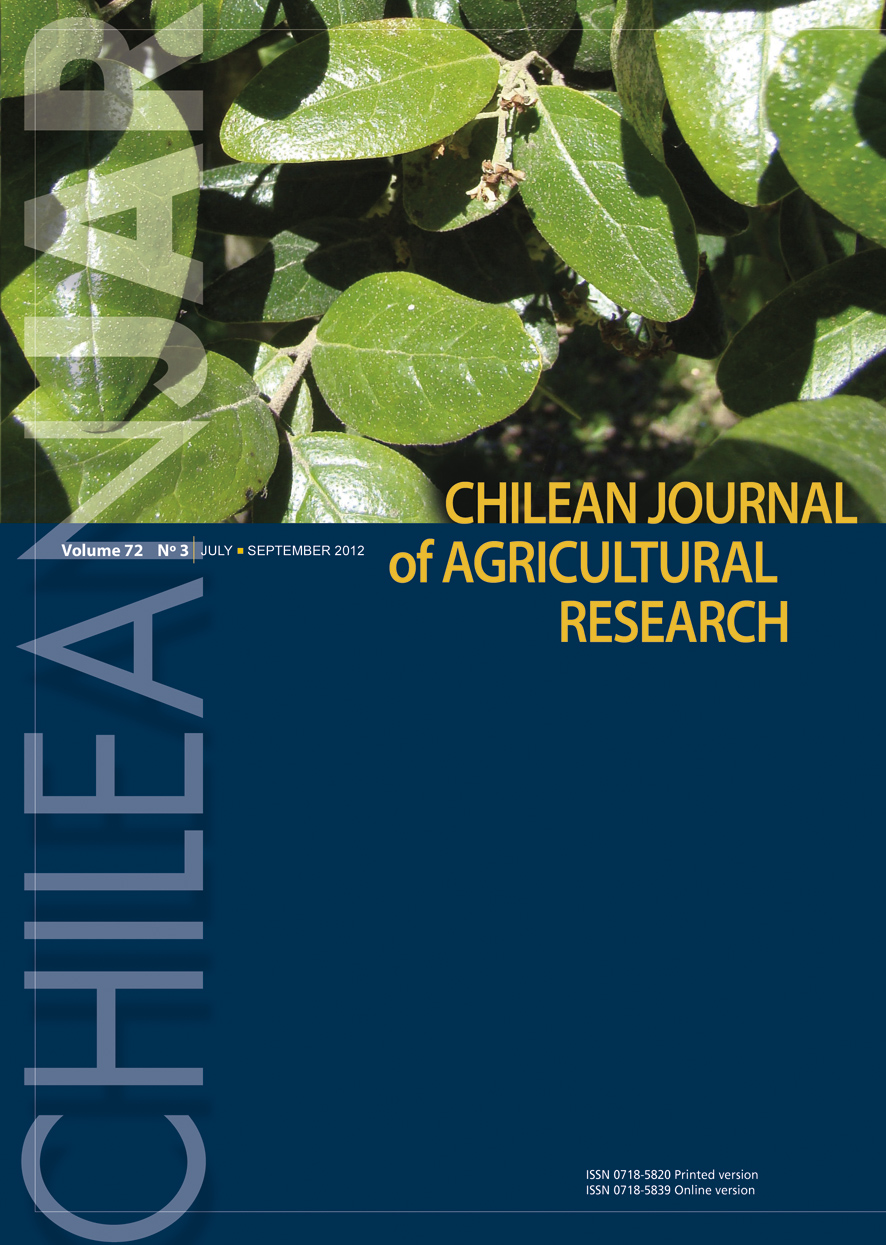
|
Chilean Journal of Agricultural Research
Instituto de Investigaciones Agropecuarias, INIA
ISSN: 0718-5820
EISSN: 0718-5820
Vol. 70, No. 2, 2010, pp. 328-336
|
 Bioline Code: cj10036
Bioline Code: cj10036
Full paper language: English
Document type: Research Article
Document available free of charge
|
|
|
Chilean Journal of Agricultural Research, Vol. 70, No. 2, 2010, pp. 328-336
| es |
Influencia de la temperatura del agua y el estrés calórico sobre el consumo de agua de bebida en vacas lecheras
Pereyra, Ana Valeria González; May, Verónica Maldonado; Catracchia, Carlos Guillermo; Herrero, María Alejandra; Flores, Myriam Celina & Mazzini, Mariana
Resumen
Los animales en pastoreo están expuestos al
estrés calórico, siendo fundamental proveer agua en
condiciones que faciliten su consumo. Se desarrollaron
tres experimentos para determinar las relaciones entre
el consumo del agua de bebida con la temperatura del
agua y el estrés calórico, en vacas lecheras en pastoreo.
Experimento 1: Se evaluó el comportamiento de abrevado
en 13 vacas (3 días consecutivos), estableciéndose cuatro
franjas horarias según índice de temperatura y humedad
(THI): (H1:05:00-10:59 h, H2:11:00-16:59 h, H3:17:00-
22:59 h y H4:23:00-04:59 h). En H2 (THI: 74,91-83,95)
se registró el mayor porcentaje medio de accesos al
bebedero (53,2%). Las medianas de los eventos “beber”
por franjas horarias resultaron diferentes (p < 0,05),
demostrándose que las condiciones de estrés calórico
influyen sobre el comportamiento de bebida. Experimento
2: Tres bebederos con agua fueron colocados al sol (S) y
tres bajo estructura de red 80% sombra (MS), a 2,2 m de
altura, registrándose la temperatura del agua a las 10:00,
13:30 y 17:00 h, dos veces por semana (6 semanas). A las
17:00 h la temperatura media del agua, 33,2 ± 1,6 ºC (S)
y 25,3 ± 1,9 ºC (MS) presentó diferencias significativas
(p < 0,05), mostrando el efecto de MS. Experimento 3:
Se ofreció agua a 18 y 31 ºC (T1 y T2) durante 10 min
dos veces al día (5 d) a cinco vacas. No hubo diferencias
significativas entre las proporciones de respuesta a los
tratamientos (p > 0,05). Se registró menor consumo con
T1 (18 L) respecto a T2 (35,9 L), pero mayor disipación
de calor corporal (T1 = 672,64 kJ d-1
, T2 = 620,76 kJ d-1
).
Palabras-clave
comportamiento de abrevado, época estival, ITH, granjas lecheras pastoriles
|
| |
| en |
Influence of water temperature and heat stress on drinking water intake in dairy cows
Pereyra, Ana Valeria González; May, Verónica Maldonado; Catracchia, Carlos Guillermo; Herrero, María Alejandra; Flores, Myriam Celina & Mazzini, Mariana
Abstract
Grazing animals are exposed to heat stress and there should be conditions to facilitate water intake. Three experiments were carried out to determine the relationship between water intake, water temperature, and heat stress for Holstein pastured dairy cows. Experiment 1: Drinking behavior of 13 cows was evaluated (for 3 consecutive days) and four time periods were established according to the temperature humidity index (TI-11): (H1:05:00 to 10:59 h, H2: 11:00 to 16:59 h, H3:17:00 to 22:59 h, and H4:23:00 to 04:59 h). The highest mean percentage of drinking bouts (53.2%) was registered in H2 (THI: 74.91 to 83.95). Drinking bout means among time periods were different (p < 0.05), thus showing that heat stress conditions influence drinking behavior. Experiment 2: Three water troughs were placed in the sun (S) and three under a 2.2 m high structure covered with shade cloth (MS). Water temperature was registered at 10:00, 13:30, and 17:00 h, twice a week for 6 weeks. Mean water temperatures at 17:00 h were 33.2 ± 1.6ºC (S) and 25.3 ± 1.9ºC (MS) and showed significant differences (p < 0.05), thus supporting the shade cloth effect. Experiment 3: Five cows were offered water simultaneously at 18 and 31 ºC (Tl and T2), for 10 min, twice a day for 5 d. There were no significant differences among treatments (p > 0.05). Recorded water intake in Tl (18 L) was lower than in T2 (35.9 L), although body heat dissipation was higher (Tl = 672.64 kJ d -1 , T2 = 620.76 kJ d -1 ).
Keywords
drinking behavior, summer time, THI, grazing dairy farms
|
| |
© Copyright 2010 Chilean Journal of Agricultural Research.
Alternative site location: http://www.inia.cl
|
|